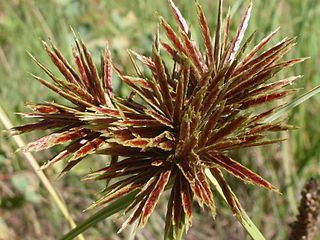| Cyperus oxycarpus | |
|---|---|
| Scientific classification | |
| Kingdom: | Plantae |
| Clade: | Angiosperms |
| Clade: | Monocots |
| Clade: | Commelinids |
| Order: | Poales |
| Family: | Cyperaceae |
| Genus: | Cyperus |
| Species: | C. oxycarpus |
| Binomial name | |
| Cyperus oxycarpus | |
Cyperus oxycarpus is a sedge of the family Cyperaceae that is native to Australia. [1]

The Cyperaceae are a family of graminoid (grass-like), monocotyledonous flowering plants known as sedges, which superficially resemble the closely related rushes and the more distantly related grasses. The family is large, with some 5,500 known species described in about 90 genera, the largest being the "true sedges" genus Carex with over 2,000 species. These species are widely distributed, with the centers of diversity for the group occurring in tropical Asia and tropical South America. While sedges may be found growing in almost all environments, many are associated with wetlands, or with poor soils. Ecological communities dominated by sedges are known as sedgelands.
The rhizomatous perennial sedge typically grows to a height of 0.3 to 0.9 metres (1.0 to 3.0 ft) and has a tufted habit. It blooms between March and April and produces brown flowers. [1]

In botany and dendrology, a rhizome is a modified subterranean plant stem that sends out roots and shoots from its nodes. Rhizomes are also called creeping rootstalks or just rootstalks. Rhizomes develop from axillary buds and grow horizontally. The rhizome also retains the ability to allow new shoots to grow upwards.
In Western Australia it is found around wet areas in the Kimberley region where it grows in clay soils. [1]

Western Australia is a state occupying the entire western third of Australia. It is bounded by the Indian Ocean to the north and west, and the Southern Ocean to the south, the Northern Territory to the north-east, and South Australia to the south-east. Western Australia is Australia's largest state, with a total land area of 2,529,875 square kilometres, and the second-largest country subdivision in the world, surpassed only by Russia's Sakha Republic. The state has about 2.6 million inhabitants – around 11 percent of the national total – of whom the vast majority live in the south-west corner, 79 per cent of the population living in the Perth area, leaving the remainder of the state sparsely populated.

The Kimberley is the northernmost of the nine regions of Western Australia. It is bordered on the west by the Indian Ocean, on the north by the Timor Sea, on the south by the Great Sandy and Tanami Deserts in the region of the Pilbara, and on the east by the Northern Territory.


